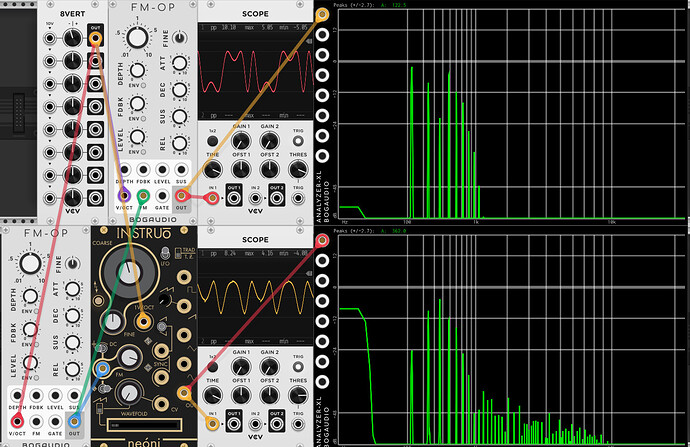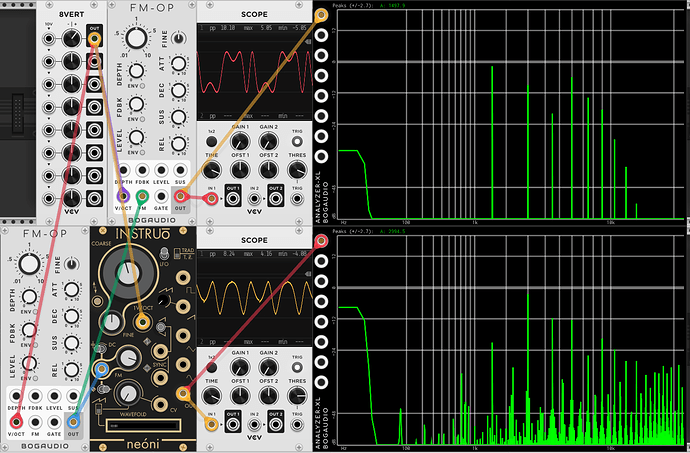No, it takes +/- 1 V to reach the carrier base frequency (actually ~1.072)
OK, this was all driving me nuts. Regardless what the end sound is, I would like to know what each of the oscillators is doing from a frequency standpoint when applying true FM. And there is not much consistency with the 3 oscillators I looked at in V2 - Neoni, VCV VCO, and Bogaudio VCO.
To investigate, I opted to apply constant voltages into FM input, with attenuation set at 100%
VCV Fundamental VCO, Exponential FM mode:
- 0V no impact - the frequency remains the same
- 1V frequency is x2 - 1 octave up
- 2V frequency is x4 - 2 octaves up
- -1V frequency is /2 - 1 octave down
- -2V frequency is /4 - 2 octaves down
Perfect - exactly as I expect. The FM input at 100% attenuation is basically an alternate V/Oct input.
To prove it, I also applied an audio rate signal attenuated to say 10%. The sound when patched into the V/Oct input is identical to the sound when patched into the FM input at 100%.
VCV Fundamental VCO, Linear FM mode:
- 0V - no impact, the frequency remains the same.
- 1V - frequency increased by ~261.63 Hz.
- 2V - frequency increased by ~523.26 Hz
- -1V - frequency is reduced by ~261.63 Hz
- –2V - frequency is reduced by ~523.26 Hz
So each volt represents 261.63 Hz = C4
If the base frequency is C4, then 1V is up 1 octave, 3V is up 2 octaves. -.5V is down 1 octave, -.75V is down 2 octaves. etc. Importantly, -1V and lower stalls the oscillator at 0 Hz
The Hz per volt remains constant regardless the base frequency. So if the base is C5, then 2V is up 1 octave. 6V is up 2 octaves, -1V is down 1 octave, -1.5V is down 2 octaves, and -2 stalls the oscillator at 0 Hz.
Again, exactly what I expect. It is what I expected before I experimented, except I didn’t know how many Hz 1 volt represented. Now I know.
Bogaudio VCO, Exponential FM mode
Exactly the same as VCV VCO. 0V no change, 1V up 1 octave, 2V up 2 octaves, -1 down 1 octave, etc.
But there is one very important difference. The sound when patching audio rate signal attenuated to 10% into FM at 100% is radically different then what I get when patching into the V/Oct. The FM input is much cleaner, the V/Oct very harsh.
If I use LFO modulation, then the sounds are basically the same, though the spectrogram of the V/Oct is still dirtier.
What on earth is going on here? The only guess I can come up with is the voltage at the FM input is maybe sampled at a higher rate than the voltage at the V/Oct input. So maybe the V/Oct input is introducing some type of aliasing? I tried looking at the code, but I’ve never done any such coding, so I don’t know what I am looking for. I did find the code that uses phase modulation for linear FM though.
Bogaudio VCO, Linear FM
Well, Bogaudio uses phase modulation, so there is nothing to compare. Applying any constant voltage to the FM input has no impact - perfectly understandable. The FM input only has effect when the voltage is varying.
Instruo Neoni
This beast is entirely different! First off, the FM must be in DC coupled mode for a constant voltage to have any effect. That makes sense. But what effect does it have?
Instruo Neoni, Exponential FM
Neoni does not have an exponential FM input. The only way to get exponential FM is to use the V/Oct input.
Instruo Neoni, Linear FM (Traditional) base frequency at C4
First oddity, setting FM attenuation to 1 (100%?) without any input increases a C4 by ~11.3 Hz.
But after actually patching input it gets even weirder - there is nothing traditional that I can see. The formula for frequency is approximated by:
frequency = |Base / 2.1 * (Volts + 2.1)|.
The bars represent absolute value. So the oscillator stalls at -2.1, but not negative values less than that.
The other piece of the puzzle is the waveform is inverted about 0 when the voltage is <= -0.2V. So a saw wave becomes a ramp when negative voltages are involved. (except for the narrow negative range > -0.2)
The number of Hz per volt is not a constant - it depends on the base voltage. So with that formula, regardless of base voltage, -2.1 constant voltage stalls the oscillator. 0V = the base frequency, and -4.2V = base frequency inverted. 4.2 and -6.3 are both one octave up.
Neoni clips incoming FM voltage at +/- 10V, so 8.3V is two octaves up, but you can not get to two octaves up with a negative value.
I don’t see how this can be called traditional, at least from the stand point of how the end result is generated. Maybe the sound is similar to simple linear FM, but I guess you can call this “through -2.1 linear FM”!
Instruo Neoni, Linear FM (Through zero)
This is very similar to the “traditional” setting, except the stall point is at 0V where one would expect, and the divisor is 1.07 instead of 2.1. The point at which the waveform is inverted remains at -0.2V
So the formula becomes
frequency = |Base * Volts / 1.07|
This formula is symmetric around 0V, so it makes sense the end result is more harmonious.
![]()



